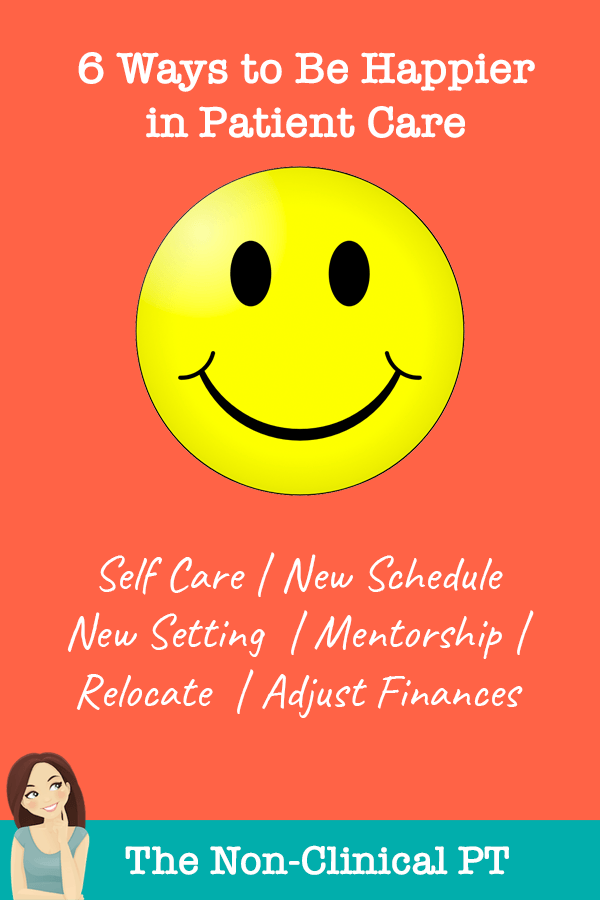If you’re reading this right now, there’s a good chance you’re entertaining the idea of moving away from patient care. Sick of managers breathing down your neck about productivity expectations, aching at the end of the day from tough transfers or awkward positions, and frustrated by barely making your loan payments at the end of the month, you are wondering, “How much longer can I take this?”
I get it. I’ve been there. We’ve all been there.
However, I’d like to play devil’s advocate and suggest some reasons you may not want to completely abandon ship just yet for a non-clinical job. I speak from experience here, as I’ve more than once seriously considered leaving therapy altogether. However, I’ve been able to make tweaks to my situation that have substantially improved my job satisfaction.
But wait. Before I get into the specific suggestions, I’d like to review a simple, yet profound, concept:
Identify The Problem.
Yes, Identify The Problem. It sounds pretty basic, but it’s something we often overlook. Are you accurately identifying what the true source of your unhappiness is?
Often, our logic flows like this: I’m unhappy with my work → I’m done with patient care

I’d like to suggest that the source of your unhappiness might be more complex than just hating your role as a therapist. Therefore, the solution of quitting patient care, while enticing, may not solve your real problem. In the case that leaving patient care truly is the right thing to do, it’s still so important to reflect on precisely why you are leaving and what you are hoping to get in exchange, because you don’t want to find yourself unhappy again, just in a different job. We spent tens to hundreds of thousands on our degrees, not to mention years of our lives, so the decision must not be made lightly.
So, with that in mind, I’d like to suggest some tweaks you can make to your current situation, to see if you can be happy in patient care.
This post may contain affiliate links or codes. This won’t increase your cost, but it helps keep TNCPT alive, and free of annoying ads! Thank you for your support. 🙂
Six ways to be happier in patient care:
1. Practice good self-care
Ok, this is a little trite and obvious. But clichés are clichés for a reason: they are true! If you’re exhausted from lack of sleep, and you’re feeling sluggish from lack of exercise and poor nutrition, you’re not going to feel your best no matter what job you have. There are a million resources out there that dive into this concept much more thoroughly than I can here, but here are some brief ideas to get you started:
- Exercise regularly: Find something you enjoy doing that you can incorporate into your routine three to four times per week. Start small, and ideally, do it with a buddy to keep you accountable.
- Eat well: Try to incorporate at least one fruit or vegetable into every meal. I find that meal planning on the weekends is critical to making this actually happen.
- Sleep well: Go to bed at the same time every day (use an alarm for a reminder!), and avoid screens for an hour before bedtime.
- Keep your home tidy: Sounds silly, but I’ve found there is a huge change in my temperament if my home is clean and organized. Start with the two-minute rule: if it takes less than two minutes to do (hang up your coat, put a couple dishes in the dishwasher), just do it right now.
- Use your vacation time: This one is obvious. Take breaks!
- Connect with friends and family: This depends on your values and your personal situation, but to me, this is pretty much the most important thing you should do in life. It’s also really easy to let weeks or even months pass between seeing close friends and family, because we’re drained from work and forget to spend social energy making (and keeping!) plans. Get yourself organized to make plans to make sure that it happens.
- Find a spiritual outlet: If this is important to you, make it a priority.
2. Adjust your hours

In modern America, the forty hour workweek is standard, and is usually assumed and unquestioned. However, this is basically made up; it’s a product of labor reform following the industrial revolution, and is hardly a gold standard of what is most productive or best for our health.
Many jobs have no flexibility in this standard, meaning you can work forty hours a week, or zero. As therapists, we have a HUGE advantage here, as you can pretty much take your pick of how many hours you want to work.
I had a job working four, ten-hour days, and I was feeling pretty burned out; I had just finished a grueling residency and was pulling about 10-15 hours per week studying for a specialist exam.
I asked my bosses if I could drop to 37 hours a week. They approved, and it was amazing how much it helped to tip the scales of the life/work balance back to a reasonable level. To me it was like a release valve that prevented an explosion, and I would say it was a pretty good return on investment for only three hours less pay per week.
Your boss may be more willing than you think to let you make a small adjustment. It’s expensive to hire and train new staff, which may not be worth it to them if you’re only asking for a few hours off.
Take a look at your finances, talk to your boss, and see if you can work something out.
3. Try a different setting
This is another huge advantage to therapy: there is a whole WORLD of different settings to try. If you’re sick of the grind of working in a SNF, maybe you just need to get out of SNFs and not out of therapy in general.
Each setting has its pros and cons, and maybe you need to branch out to see which cons you can tolerate and which pros are more important to you. Something to consider here is travel therapy.
Travel therapy allows you to take short-term contracts, so you can try a bunch of different settings in a short time frame, allowing you to see what fits your skills and interests best. Plus, the pay is typically better, and you get to travel the country! Perhaps you will find the constant excitement and change of travel therapy itself is what suits you best.
4. Continuing education and mentorship
It is really, really hard to enjoy a job that you don’t feel confident in. My first job as a new grad was in outpatient pediatrics, and it was pretty rough. I hadn’t had any clinical experience in that setting and, despite promises my employer made in the interview, I had very little mentorship. I knew the road I was heading down was not a good one, and I needed to change something.
I applied to a few residencies and was ultimately offered the pediatric residency at Duke.
While I do still constantly struggle with self-doubt, and I’ll certainly always have more to learn, I have a much better baseline of background knowledge, and I feel more confident in my work, which helps me enjoy my role more.
We are often our own worst critics. While you are probably doing better than you think you are, you may benefit from reflecting on your own skills and experience, and examining where weaknesses are. Seek out mentorship and continuing education based on your self-reflection.
Mentorship may take some work to find if it’s not built in to your job, and continuing education can be expensive and require travel, so be prepared to encounter some barriers there.
Consider online continuing education, such as Medbridge, which is much less expensive, but can still hone your skills. However, neither is impossible to find and both are worthy investments to feel more confident in your work and to be able to better serve your patients.
Editor’s note: Another, even less expensive, option is PhysicalTherapy.com / OccupationalTherapy.com / SpeechPathology.com. I have been using them since 2010, and still go there for clinical information and last-minute CEUs when I’m renewing my physical therapy license. Read my review of PhysicalTherapy.com here, and get a discount if you decide to join! I also highly recommend platforms like the OT Potential Club (an online journal club/forum) and The Learning Lab by Seniors Flourish. Both of these resources are specific to OTs looking to improve their skills and better serve their patients.
5. Adjust your geography
It’s possible that your geographic circumstances are contributing to your unhappiness.
- Are you far away from family?
- Do you live in a climate that is not agreeable with your physiology?
- More likely, is your commute getting you down?
Moving is never fun, but the short-term headache may pay off in long-term happiness if you rearrange to have a more manageable living situation.
6. Consider radical changes to finances

Finances should be a strong consideration before you take the leap out of patient care. You probably invested a huge amount of money into your degree, and there is a high opportunity cost of abandoning a pretty decent salary potential from therapy jobs.
With that in mind, you could consider sticking it out in your current field, but radically changing your spending habits and cost of living to be able to retire (or drop to part time) considerably sooner.
The movement behind this concept is called “extreme early retirement.” Google that phrase and you’ll find myriad resources to inspire and instruct you. My own personal favorites are the Mr. Money Mustache and Frugalwoods blogs, but I’ll summarize an intro here.
The basic premise of extreme early retirement is about either decreasing your spending or increasing your income to achieve a higher savings rate. The goal is to save 25 times your annual expenses. This is based on the 4% rule, which states that you are ready to retire once you have saved enough to live off of 4% of your investments.
If you stay at or below this rate, you’ll be able to live off the interest of your investments indefinitely.* You can do the math yourself to calculate your own savings rate (net savings divided by total income after tax), and the table below gives you an estimate of how much longer you will need to work before you can retire, based on that savings rate.
Once you are armed with that information, you can choose one of three paths:
- First: if you’re happy with that number, change nothing and stay the course.
- Second: find a way to increase your income in order to reduce the working years remaining while sustaining your spending habits and lifestyle.
- Third: reduce your spending and decrease your cost of living. The beauty of the third path is the double advantage of both reducing the total amount you will need to live off of, and simultaneously increasing your savings rate by not spending as much. To use a race analogy, that’s like increasing your running speed while simultaneously moving the finish line closer.
| Savings Rate (%) | Working Years Until Retirement |
|---|---|
| 5 | 66 |
| 10 | 51 |
| 15 | 43 |
| 20 | 37 |
| 25 | 32 |
| 30 | 28 |
| 35 | 25 |
| 40 | 22 |
| 45 | 19 |
| 50 | 17 |
| 55 | 14.5 |
| 60 | 12.5 |
| 65 | 10.5 |
| 70 | 8.5 |
| 75 | 7 |
| 80 | 5.5 |
| 85 | 4 |
| 90 | under 3 |
| 95 | under 2 |
| 100 | Zero |
Everybody gets to make their own choices about how they want to handle their finances, and we all have unique situations with specific challenges and advantages. What is important is to take stock of your own situation and make plans to get where you want to be, and not just run on autopilot and assume everything is just going to work out.
Certainly if you are considering a career change, it would be a mistake to make a drastic change without working out an estimate of how it changes your financial picture, both currently and in the future.
Identify The Problem
Yup, I’m bringing “Identify The Problem” back again, because I believe so strongly in this concept! I’ve included everything in the list above because it has helped me, but your own personal circumstances may call for a change that I haven’t mentioned. What exactly is it about your current job that isn’t working for you? Do some soul searching to figure out what’s getting you down, and take action to change it.

*This rule depends on market returns, which vary from year to year, and therefore should be taken as an estimate. It also does not assume any income from social security or other resources you may have. Some say the 4% rule is risky and you should save more; others will say it’s too conservative and you can retire sooner. Do your own research and decide for yourself how much risk you can tolerate vs. how quickly you want to retire.





